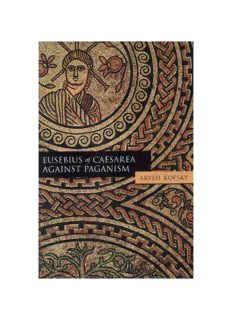
Eusebius of Caesarea Against Paganism (Jewish and Christian Perspectives) PDF
Preview Eusebius of Caesarea Against Paganism (Jewish and Christian Perspectives)
Eusebius of Caesarea against Paganism Aryeh Kofsky VOLUME 3 Eusebius of Caesarea against Paganism by Aryeh Kofsky '/68V BRILL LEIDEN · BOSTON 2000 This book is printed on acid-free paper. Library of Congress Cataloging-in-Publication Data A C.I.P. record for this book is available from the Library of Congress. ISBN 90 04 11642 7 © Copyright 2000 by Koiiinklijke Brill NV, Leiden, The Netherlands. Koninklijke Brill NV incorporates the imprints Brill Academic Publishers, Martinus Nijhoff Publishers and VSP. All rights reserved. No part of this publication may be reproduced, translated, stored in a retrieval system, or transmitted in any form or by any means, electronic, mechanical, photocopying, recording or otherwise, without prior written permission from the publisher. Authorization to photocopy items for internal or personal use is granted by Brill provided that the appropriate fees are paid directly to The Copyright Clearance Center, 222 Rosewood Drive, Suite 910, Danvers, MA 01923, USA. Fees are subject to change. PRINTED IN THE NETHERLANDS In memory of my mother CONTENTS Preface xi Abbreviations xiii Introduction 1 Chapter One: Background. Apologetics and Polemics before Eusebius 5 The Caesarea!! Background 12 The Persecutions 15 Porphyry's Polemic against the Christians 17 The Contents of the Fragments 25 Chapter Two: Apologetics and Polemics in Non-Apologetic and Early Apologetic-Polemical Works I. Apologetics in Non-Apologetic Works 37 The Chronicle 38 The Ecclesiastical History 40 The Life of Constantine 45 In Praise of Constantine 48 II. Early Apologetic-Polemical Writings 50 The General Basic Introduction and the Prophetic Extracts 50 Against Hierocles 58 Against Porphyry 71 Chapter Three: Praeparatio Evangelica and Demonstratio Evangelica - A Single Apologetic-Polemical Enterprise General Plan, Basic Characteristics and Principal Questions 74 Internal Division 85 The Jewish Aspect of the Demonstratio Evangelica 89 Chapter Four: The Concept of Christian Prehistory - A Central Axis of the Polemic I. Development of the Conception 100 II. Major Conceptual Problems and Thar Solutions 114 The Life of Jesus according to the Law of Moses 114 The Numerous Progeny of the Patriarchs 115 The Problem of Sacrifices 118 The Christians' Neglect of Science - A Conceptual Difficulty and Polemical Problem; The Apologetic Role of Socrates 123 The Concept of the Development of Polytheism and Its Complementary Apologetic Role 130 Chapter Five: Prophecy in the Service of Polemics Pagan Oracles and Hebrew-Christian Prophecy 138 The Actualization of Biblical Prophecies 148 Jesus the Prophet 150 The Vague Language of Prophecy 151 An Example of Apologetic Interpretation of Prophecy 155 Conclusion 163 Chapter Six: Miracles: A Major Subject in Eusebius' Polemics Eusebius' Ambivalent Attitude to Miracles 165 Miracles as Proof of the Divinity of Jesus and the Truth of the Christian Faith 170 The Difficulty of Proving the Divinity of Christ on the Basis of Miracles 174 On Those Who Reject the Authenticity of Jesus' Miracles .... 181 On Arguments that Miracles Depend on Magic and Sorcery 196 On Arguments Alleging Jesus' Weakness, Wretchedness and Cowardice 209 Chapter Seven: Minor Apologetic-Polemical Arguments and Issues The Roman Empire and the Incarnation 215 The Persecutions 220 On Arguments Concerning the Late Date and Geographical Remoteness of Jesus' Appearance 224 On Criticism of the Literary Style of Scripture, and Contradictions between the Old and New Testaments, and between the Gospels 227 On Prophecy in the Book of Daniel 233 Other Implied Arguments 235 Chapter Eight: 'Tactics, Rhetoric, and the Role of Porphyry in the Dual Composition I. Tactics and Rhetoric 241 II. The Role of Porphyry in the Dual Composition (PE-DE) 250 Porphyry as Supporting Testimony 253 A Critique of Porphyry's Views and Inconsistencies 264 Chapter Nine: 771e Theophany: The Final Apologetic Statement General Analysis 276 The Attitude to Plato 282 Peace, Empire, Incarnation, and the Success of Christianity 286 Resurrection 287 The Fulfillment of the Prophecies of Jesus as Argument and Proof 294 Conclusion 312 Bibliography 315 Indexes Names and Subjects 323 Sources 332
Description: